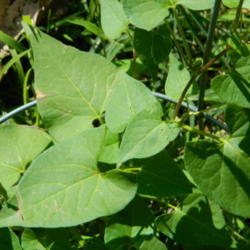
Wild buckwheat (Polygonum convolvulus) is easily confused with field bindweed, but wild buckwheat is a summer annual. Most common in cool climates, wild buckwheat seeds sprout in late spring, and the plants quickly twine up their closest upright neighbor. Tiny greenish white flowers quickly produce seeds. Pull young plants, or cultivate with a sharp hoe. If seedlings are numerous, spray them with an organic herbicide containing clove oil. Clip the base of older plants that have wound themselves around corn or tomatoes to reduce reseeding.
Weed Control TechniquesPulling. Most young weeds can be pulled from the soil. They will slide out most easily if you pull them when the soil is wet. Getting the root up is crucial, so think of the main stem as the root's handle, and grasp it as close to the soil line as you can. If you find that the weeds are breaking off at the crown as you pull, slip a kitchen fork, dandelion weeder, or similar tool under the weed, and pry and twist as you pull it up. Weeds that have taproots, such as dandelion and plantain, usually must be pried out. A flexible pair of waterproof gloves will keep your hands comfortable as you weed, and it's good to have a nice sitting pad, too. Let pulled weeds bake in the sun for a day or so before composting them. If pulled weeds are holding mature seeds, compost them separately in a hot, moist pile before using this compost in the garden.
Organic herbicides. There are several herbicides made from natural ingredients. Those that contain clove oil (eugenol) give the best control of young broadleaf weeds. Products containing acetic acid, often in combination with citric acid, do a good job on young grasses. Some products contain both clove oil and acetic acid, so they are useful for a broad variety of weeds. Soap-based herbicides dehydrate leaves by cutting through their protective layer of cutin. All of these types of organic herbicides work best on young weeds and pose only a temporary setback to well-rooted perennial weeds. To minimize damage to neighboring plants, spray only in dry, still weather. To maximize effectiveness, spray young weeds when temperatures are above 70 degrees F and the sun is shining brightly. Be aware that repeated applications of a product containing acetic acid (which is very strong vinegar) can lower the soil's pH, making it more acidic.
Reducing reseeding. Most weeds reproduce primarily from seeds, and the seeds of some weeds can remain viable when buried in the soil for decades. So it's essential to keep weeds from shedding seeds in the garden. Garden weeds that are neglected until they reach seed-bearing age can be lopped off near the soil line with pruning shears, a stout knife, or a string trimmer with a blade attachment. Cutting back perennial weeds again and again not only reduces reseeding, it also forces the plants to use up food reserves stored in their roots. In a garden that has gone hopelessly weedy, mowing it down promptly, raking out the seed-bearing debris, and starting over next year is a big step in the right direction. Mowing regularly helps keep weeds under control in lawns. When mowing lawns where seed-bearing weeds are present, collect the clippings in a bagger and dispose of them in a shady place.
Photo courtesy of Randall G. Prostak, University of Massachusetts
 |
 |
 |
 |